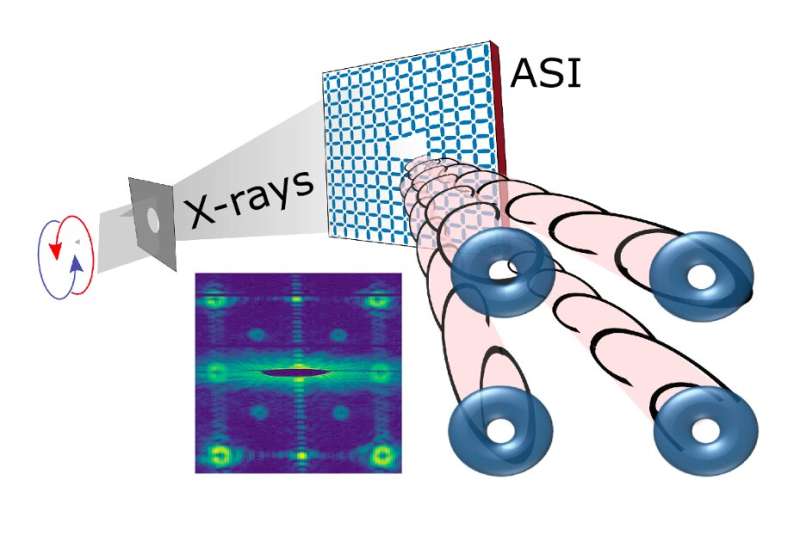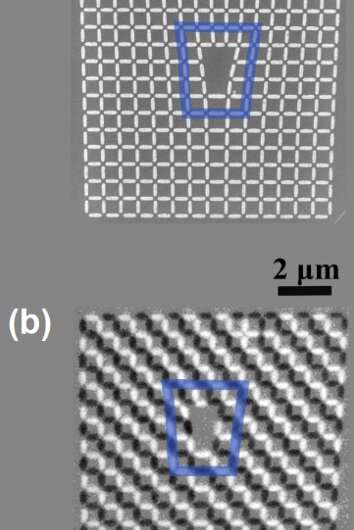April 22, 2021 feature
A new method to generate and control orbital angular momentum beams

Artificial spin ices (ASIs) are magnetic metamaterials with exotic properties that are dependent on their geometries. Over the past few years, many physicists have studied these materials, as their unique properties could be advantageous for a number of applications.
Researchers at University of Kentucky, Argonne National Laboratory, Lawrence Berkeley National Laboratory and other institutes in the U.S. have recently introduced a method to achieve switchable X-ray orbital angular momentum (OAM) in ASI magnetic systems. Their approach, presented in a paper published in Physical Review Letters, could pave the way for new research investigating the properties of magnetic systems, ferroelectrics, chiral systems and nanostructures.
"I am very interested in the topic of photons carrying orbital angular momentum (OAM)," Sujoy Roy, one of the researchers who carried out the study, told Phys.org. "In the visible light community there has been a lot of work in this area, but in the case of X-rays there have are been limited reports. So, we started looking into it and we were the first one to successfully generate OAM carrying soft X-ray beams."
In a previous paper published in Nature Photonics, Roy and his colleagues showed that they could successfully generate OAM-carrying soft X-ray beams by fabricating a specialized grating with a fork dislocation. Subsequently, while they were researching 2D square ASIs, they started investigating the generation of OAM beams in instances where a material's square lattice has a fork defect.
"This was particularly interesting because our lattice was magnetic; thus it arranges itself antiferromagnetically below the ordering temperature," Roy said. "Now the question is, if we introduce a fork, what happens to the antiferromagnet? Does the sample still go into an antiferromagnetic state? After a series of discussions and brainstorming within the group, we came to the conclusion that by inserting a double dislocation, the sample will still be able to go to an antiferromagnetic state."
ASIs are patterned arrays of nanomagnets that have some common properties with water ice. ASIs can often be "frustrated," which essentially means that magnets contained within them cannot align themselves with their neighbors in ways that would minimize the energy involved in their interactions. As Linus Pauling observed in 1935, hydrogen atoms in water ice are typically arranged in a similar way.
About a decade ago, physicists showed that square ASIs, first studied by a research team at Penn State University, are not actually "frustrated," but they instead enter a well-ordered antiferromagnetic ground state. This was first predicted in 2006 by Möller and Moessner and experimentally demonstrated in 2011 by Christopher Marrows and his colleagues at the University of Leeds. When they are in an antiferromagnetic ground state, the magnets in the lattice are oriented in such a way that they cancel out, so that there is no net magnetization of the ASI.
"We have been working in the area of artificial spin ices (ASIs) for some time in collaboration with Professor Lance De Long at the University of Kentucky," Todd Hastings, another researcher involved in the recent study, told Phys.org. "Another group, led by John Cumings at the University of Maryland, showed that introducing a fork dislocation (topological charge 1) in a square ASI reintroduces frustration and prevents formation of a single antiferromagnetic ground state. Our team recognized that introducing a double fork dislocation (topological charge 2) could potentially allow the antiferromagnetic ground state to reform."
In the ASI examined by Roy, Hastings and their colleagues, the topological charge (i.e., number of the fork defect) in the structure is 2, while that of the antiferromagnet is 1, leading to two different topological charges in a single system. In addition to exploring how the introduction and removal of frustration can change the charge of a single defect in square ASI systems, the researchers looked at how X-rays would scatter from these structures.
"For some time, we had been thinking about how to create X-ray beams with OAM that could be switched on and off," Hastings explained. "Light-carrying OAM can cause small objects to orbit the center of the beam and has enabled applications as diverse as quantum cryptography, optical tweezers, and telecommunications. While X-ray OAM is much less common, it can be created by diffraction from structures with fork defects. We thus hypothesized that X-rays scattered from square ASIs with forked defects would also carry OAM."
A research team led by Laura Heyderman at ETH Zurich and the Paul Scherrer Institute showed that by applying an external magnetic field to square ASIs, they could be placed in a ferromagnetic state, in which all nanomagnets are oriented in the same direction. Inspired by this previous work, Roy and Hastings hypothesized that an applied magnetic field could also switch magnetically scattered OAM beams off, and that these beams would turn back on when the system returned to its ground state.
"With this, the entire picture came together of a system that could produce X-ray beams with different order orbital angular momenta and in which the magnetically scattered beams could be switched on and off," Hastings said.
X-rays tend to be sensitive to the density of a material, but not very sensitive to magnetic moment. To achieve X-rays that are sensitive to magnetic signals, the researchers employed a technique called Resonant X-ray Magnetic Scattering (RXMS), with a coherent beam (i.e., one with a well-defined amplitude and phase). This technique allowed them to achieve higher magnetic sensitivity, by tuning the energy of the incident beam to an element's absorption edge.

"In our case, we tuned to the L3 edge of iron which is at 707 eV (for reference, Cu K alpha radiation is 8 keV) and then we diffracted off using a coherent X-ray beam," Roy explained. "Due to the beam coherence, the phase of the diffracted beam acted coherently, so that the entire outgoing beam acquired a helical phase front that gave rise to OAM."
When researchers carry out a diffraction experiment using RXMS techniques, they can observe strong peaks at certain angles that satisfy the Bragg condition, where the scattered X-rays interfere constructively. As the lattice spacing in antiferromagnets is twice that of structural lattices, the antiferromagnetic peak generally appears in a different position. This difference in position helps researchers to distinguish between charge and magnetic diffraction peaks.
"When we diffract off the forked 2D array, we get OAM beams both at structural Bragg peaks and magnetic Bragg peaks," Roy said. "However, because of the two different topological charges, we see different OAM content in the structural and magnetic Bragg peaks. Furthermore, as we can controlled the artificial spin ice with an applied field, this implied that we would be able to control the OAM content of the beam."
The nanomagnets in the ASIs used by Roy, Hastings and their colleagues were made of permalloy, an alloy of nickel and iron. To create the system they examined, the researchers wrote a pattern in a polymer on a silicon wafer, using a technique called electron beam lithography.
"Our sample was then coated with permalloy by evaporating the material in vacuum (electron beam evaporation) allowing it to deposit over the pattern," Hastings said. "Subsequently, we removed the polymer and the permalloy that rested on top of the unpatterned regions (a so-called lift-off process). Each nanomagnet was 470 nm long, 170 nm wide, and only 3 nm thick. A human hair is about 100,000 nm in diameter, so if you stood these magnets on end, about 15 million of them would fit on the end of a human hair."
When X-ray beams were diffracted at the proper angle and when the beam was tuned to the magnetic L3 edge of iron, the researchers found that the ASI system they examined entered an antiferromagnetic ground state. They later confirmed the presence of this state by directly imaging the magnetization of the nanomagnets in the system, using a technique known as X-ray magnetic circular dichroism photoemission electron microscopy (XMCD-PEEM). Using this technique, they illuminated the ASI with X-rays and captured the electrons emitted from the nanomagnets in an electron microscope.
"During the X-ray scattering experiments, we heated the sample up to about 100°C to show that the magnetically scattered beams could be switched off with temperature as the ASI switched from antiferromagnetic order to a paramagnetic state," Hastings said. "It is interesting that the permalloy itself does not become paramagnetic until about 600° C, so the ASI is imitating a paramagnet while the permalloy remains ferromagnetic."
The researchers also applied a magnetic field to the ASI they examined to orient all its magnets in the same direction. Rather than rotating in the external magnetic field, the nanomagnets changed their magnetization direction internally. The researchers found that once the ASI was no longer in the antiferromagnetic ground state, the magnetically scattered X-ray OAM beams disappeared.
"So far, the generation of OAM beam in X-ray regime was a non-trivial task," Roy said. "Now that we can generate these beams and also have a way to control them, it opens up new possibilities. For instance, these beams can be used to study topological spin textures in magnetic systems, polar vortices in ferroelectrics, chiral systems and nanostructures."
The approach for generating a switchable X-ray OAM from ASIs devised by Roy, Hastings and their colleagues could have numerous interesting applications. In addition to informing new studies examining various materials, it could open up new possibilities for the use of X-rays in quantum information science. Moreover, using the methods employed by this research team, physicists could identify other materials that could be used to generate tailored X-ray beams.
"The ability to generate controllable X-ray OAM provides an exciting new tool for studying other materials," Hastings said. "Our study also provides some insight into how artificial spin ices behave in the presence of so-called topological defects. That is, now we know that defect free square ASIs are not frustrated and order antiferromagnetically, that defects with topological charge of one introduce frustration, and defects of topological charge two remove frustration."
Roy, Hastings and their collaborators are now trying to determine whether the beams generated in their experiments are sensitive to specific features of other materials. If this is the case, their findings could create new paths and horizons for research exploring different material systems.
"In addition to applying X-ray OAM beams to study other materials, we are also studying more complex ASIs that can generate different OAM beams, exploring new ways of switching OAM, and trying to learn how topological defects affect the behavior of ASIs in more detail," Hastings said.
More information: Switchable X-ray orbital angular momentum from an artificial spin ice. Physical Review Letters (2021). DOI: 10.1103/PhysRevLett.126.117201.
Journal information: Physical Review Letters , Nature Photonics
© 2021 Science X Network





















